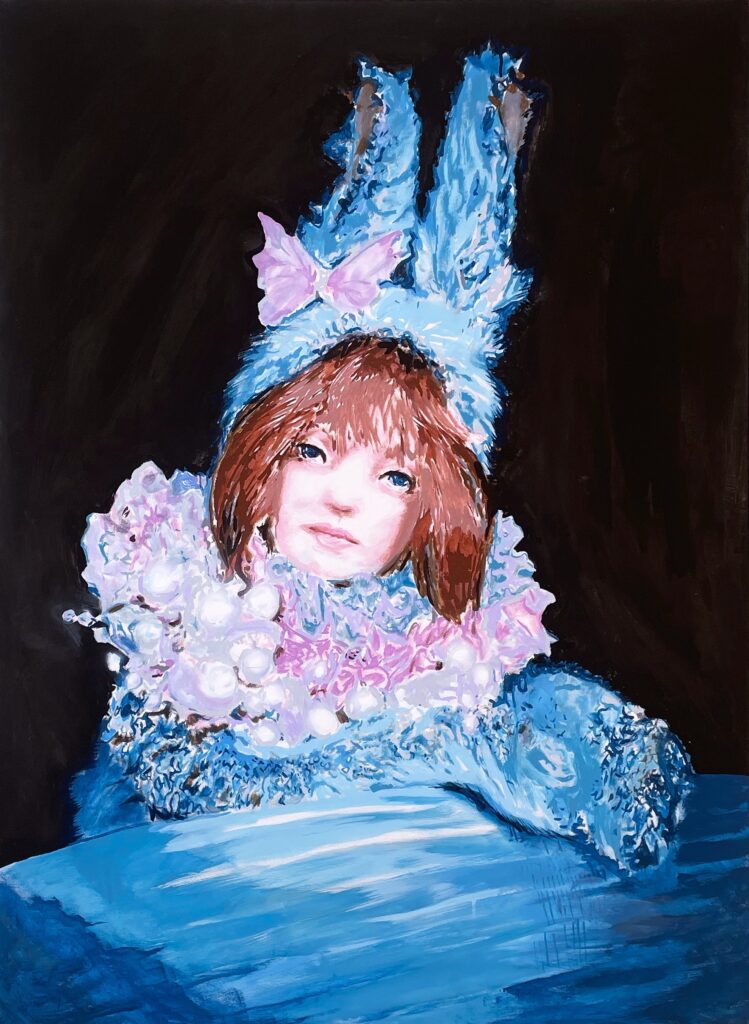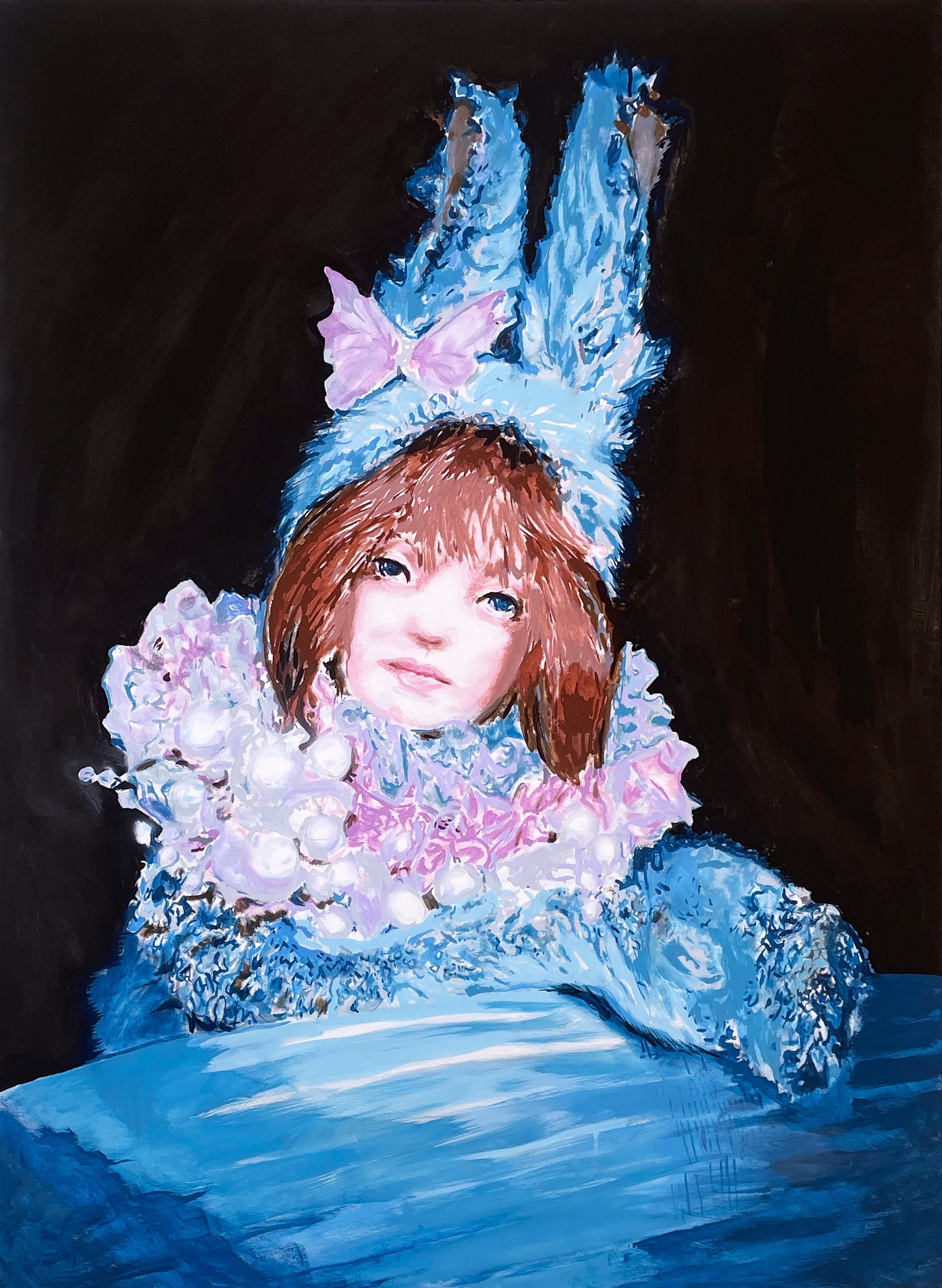If you don’t know Ruby Zarsky’s name by now, you’re overdue. Best known for her role in musical power duo Sateen, Zarsky is a central figure in the New York queer nightlife and arts scene. She’s the co-founder of downtown art gallery O’Flaherty’s, and in 2023 she spearheaded production on a pop-up all-trans strip club series. Her first solo exhibition, Platypussy, opened last Friday in the Bushwick arts venue, Intima.
Zarsky’s show, a series of ten paintings which she completed over the course of the past month (“and some change,”) is a no-punches-held exploration of fetish, appropriation, gender, and beauty. But don’t be deceived by the sheer amount of blondes with Platypussy—Zarsky is further cementing her place not only as a talented and provocative artist, but as a formidable visual philosopher.
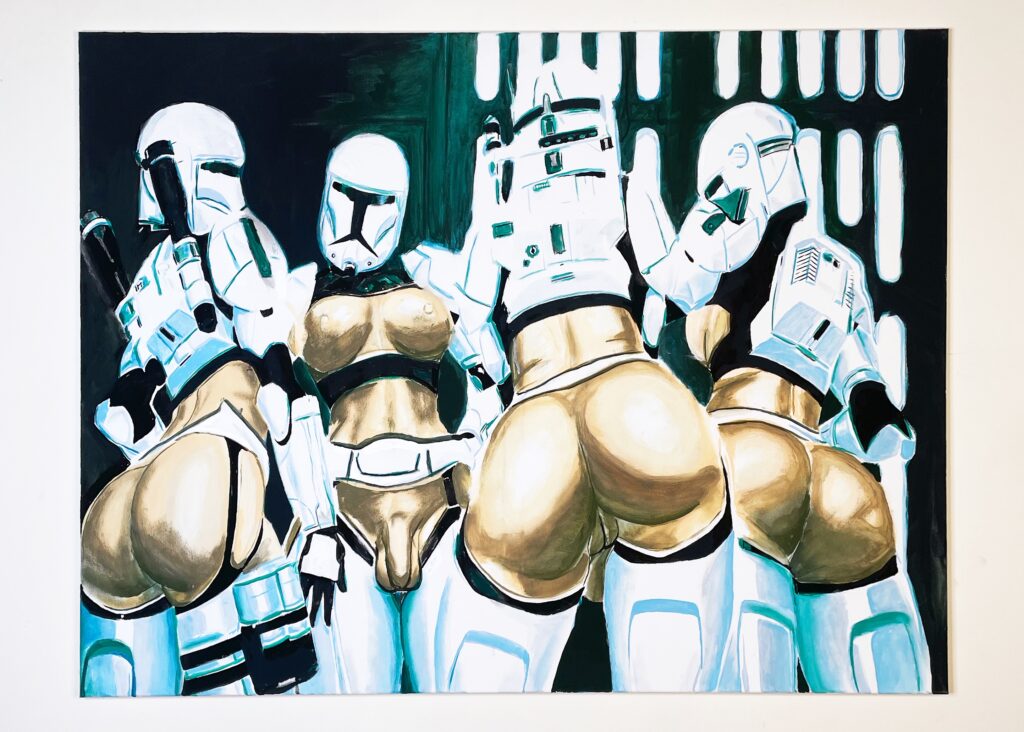
Flashe on canvas
36 x 48 inches
91.5 x 122 cm
Below, V caught up with Zarksy to discuss dildos, Star Wars, and David Foster Wallace.
Annie Martin: Let’s start with the title of the show. Can you tell me a bit more about what the symbolism of the platypus means to you?
Ruby Zarsky: I was obsessed with the platypus as a child. I never quite understood why until I was older and came into my own identity as a trans woman. It’s a metaphor for being a trans woman. The press release reads, “you might think that I’m a dam-building beaver, an egg-laying duck, or a venomous reptile.” You could call me any of those things, but you would be wrong. Actually, I’m all of those things at once, and the sum of those parts is the platypus.
AM: Can you talk a bit more about the imagery in your show, specifically the Star Wars pieces?
RZ: All those pieces, actually, are appropriated images. There’s a subsect of Japanese porn, devoted to trans characters, called futanari. I became fascinated with this depiction of trans women in what I felt was a really exploitative and intense way. Those pieces, to me, are offensive. They’re kind of these incel, troll-type characters who make this art. They’re perpetuating the narrative that trans women are overtly sexualcreatures, that we’re this dirty fetish. My whole thinking was to reclaim that imagery. I’m taking the power back by saying, “Oh yeah? Well, I’m gonna take your image.” It’s very much in a fine arts tradition. These pictures could be looked at as fan art or fetish art, if you don’t have the proper context to understand that this is, like, a Warholian maneuver that I’m pulling. These images are like Koons, or Richard Prince. I take those images and explore this relationship between me as an actual trans woman and these artists who really, in my opinion, have no business making these images.
At the same time, I appreciate the beauty of those images. My relationship with this imagery is complicated, it’s not just one sided. It’s me also saying, listen, I kind of get it, because I think that women are so beautiful, and I love women. I’m a gay woman and I appreciate the beauty of womanhood in its entirety. It’s a celebration as much as it’s a reprimand.

Flashe on canvas, Thermoplastic Elastomer, Wood Frame, Styrene Face
31 x 41 inches
104 x 79 cm
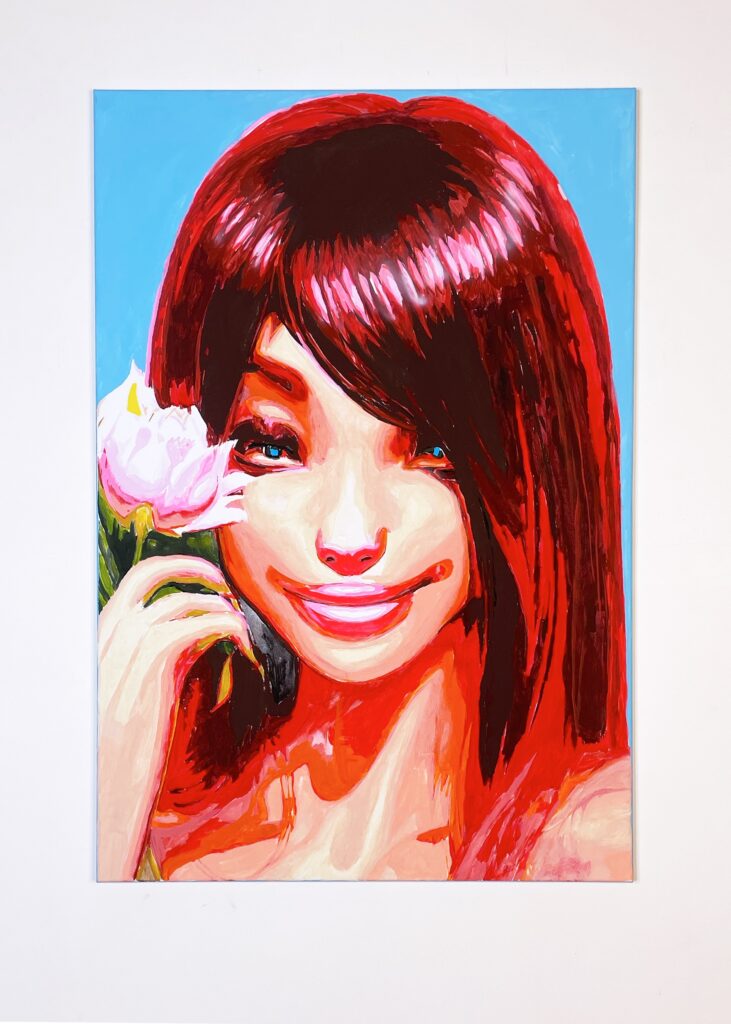
Flashe on canvas
24 x 36 inches
61 x 91.5 cm
AM: I definitely read this show as navigating the tension between the fetishization of trans women and that reclamatory gesture, the beauty of it. As queer people, our identity is thrust into the spotlight as, prominently, a sexual identity. And you know, oftentimes the same people harassing you in the street are the same people watching your porn.
RZ: Exactly. There are so many overlaps between trans issues and sex worker issues. That’s a huge part of the reason why I’ve done my strip club series. The paintings are really an extension of it all. It’s all kind of beating the same drum; it’s all about saying listen, I’m a trans woman, and this narrative is inescapable to me. Everywhere I turn, I’m going to be sexualized. And I don’t like how that’s being done, but I don’t want to be ashamed or feel like I can’t celebrate my own sexuality for myself.
AM: There’s this trend of bimbofication. A lot of times what’s going on there is what you’re talking about—it’s a lot denser than people think.
RZ: I have so many thoughts on bimbofication. We’ve been shamed into believing that to present in these feminine sorts of ways is silly or superfluous. In actuality, it’s a narrative that’s been written—probably by men—to try to control us by dulling our shine. The act of bimbofication is a really self-celebratory practice. You want me to be your little dolly? Well, I’m going to be this super creature, you can’t possess me. The irony of it is that when you look so good, when you get so much plastic surgery, when you get so many fillers and have so much makeup on, you actually are less approachable. Even though you’re technically more “beautiful,” actually, you’re more repulsive to men. Which is so appealing to me personally because I’m, like, trying to repel men.
AM: Absolutely. I’ve been thinking about that. Choosing to embody femininity in a particular way—I’m not doing that to attract men. I’m doing that to scare them off.
RZ: I mean, that’s 100% the point. And it speaks to my philosophy because it’s not just about the fact that I’m gay, but really because I view this patriarchal system as the greatest oppressive system in the whole world. It has to change.
AM: Can you tell me more about your process, and how painting is different for you than these other mediums, like your music?
RZ: The thing is, I’ve always been a visual artist. I actually went to art school, I graduated from the School of Visual Arts. I was a musician as a teenager, and that evolved more organically after I graduated from art school. But I never really strayed from making visual art. For me, painting has always been the crown jewel. I always like to say that painting or visual art is like visual philosophy, right? Painting is the closest thing to an essay that you’re going to get from me. The practice of painting involves all of art history. I’m trying to take in everything. The whole thing is like a huge chain, and each link in the chain is like a new addition, but contingent upon the previous links, right? I view my paintings as another link in that chain of progress towards understanding and deciphering these cultural conundrums that we face.
AM: …I have to ask how you sourced the dildos in this show.

Flashe on canvas, Polyvinyl Chloride
24 x 36 inches
61 x 91.5 cm

Acrylic and Flashe on canvas
36 x 48 inches
91.5 x 122 cm
RZ: This was a Duchamp move for me. They are readymade dildos that I purchased off of Amazon. Thank you, Jeff Bezos! I’m sure he would be disgusted to see what I’ve done with his products. I have big aspirations to explore that whole theme more, but again, my work is born from art history as much as it is from my cultural positioning in this contemporary landscape of trans women in New York. I look to my trans sisters and my friends and peers as much as I look to the old masters.
AM: Can you tell me about the novels you listened to while working on this show?
RZ: I’ve been revisiting some of my favorite books from my childhood while I’ve been making these paintings. One of the books is David Foster Wallace’s Infinite Jest. He’s apparently a total shitbag. And everybody hates him. But, I mean, the book is just prophetic because it foresaw so much—filters, AI, FaceTime, everything, and it was published in 1996. He’s kind of the guy that I’m fighting against in my art. But I also love the book because I’m really obsessed with vocabulary and words. The other book that I was listening to a lot was one of my all-time favorites, Lawrence Durell’s Justine. It’s all about sex and love and it’s very Freudian. It made me realize that the substance of my art, really, is love. And the substance of my art has always been love. Love is one of those things that we’re so sheepish to really address head-on. Romance is so drained from us in the digital era. It’s all lust, and it’s all very scientific and very pragmatic. But love is what I think all art should stem from, that place more than anything. I’m such a strong believer in love. It was great to revisit that book and bask in the sunlight of his vocabulary, and the way that he writes.
AM: That’s beautiful. I was not expecting you to say David Foster Wallace.
RZ: He is the ultimate troll. He’s like the commander-in-chief of the incel trolls.
AM: I want to talk to you a little bit about the space. Intima is very embedded in the queer, specifically trans, nightlife community. When this show was coming together, how did the space influence your decisions, your desires?
RZ: Oh, it was everything. They’re not site-specific paintings, I think a painting, ultimately, should be able to stand on its own anywhere you put it. But I did have in mind, OK, this is the layout, and these paintings need to be big. They need to really be colorful and assertive in this space because the space is so DIY, punk-rock and raw. I had to create a balance. The rawness of the space and the profaneness of my artwork balance each other in their extremes. It’s a more legible environment than I would have even expected.
AM: Yeah, that contrast you’re talking about was great. Everyone smoking cigarettes inside, the exposed iron, just the textural feel of the space.
RZ: It’s everything you fucking want. It felt like New York. This is what New York is supposed to be about. Like, “We’re going to see a tranny art show in New York City. What’s this shit gonna be like?” That’s what it should be, you know.
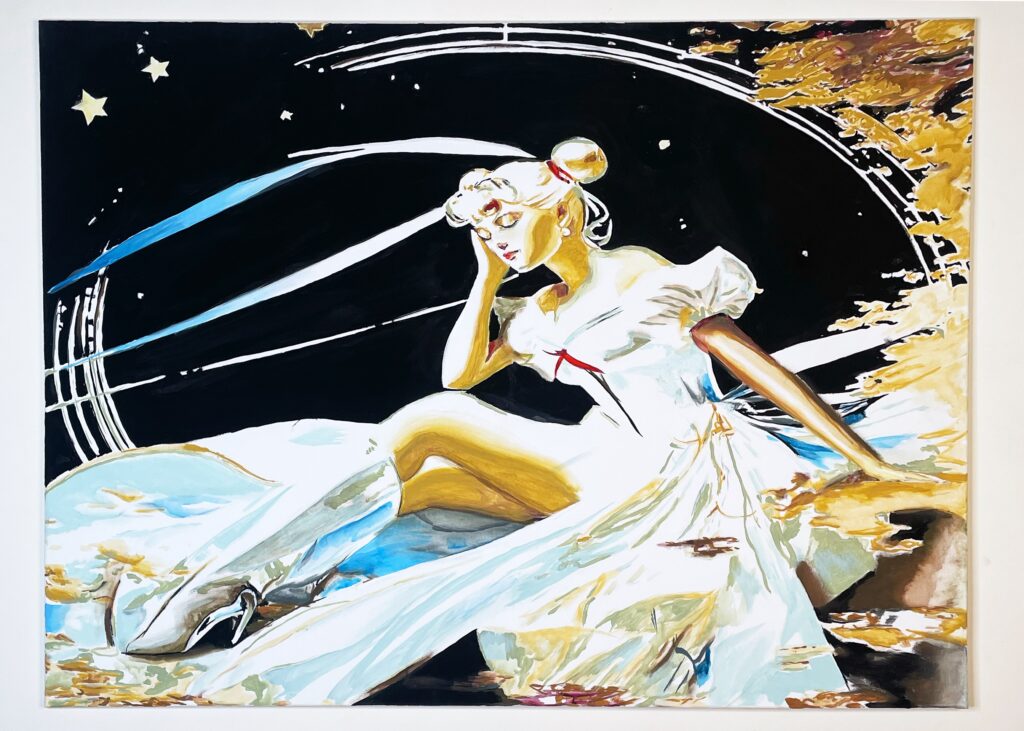
AM: For sure. It’s so essential, that DIY spirit, to the queer community, the trans community. Like, we have to get this shit done ourselves. It’s so different than if it was in a white-walled Manhattan gallery.
RZ: Absolutely. Ethos is so important in my work. With my band, it was always DIY, we did everything ourselves. I grew up in New Jersey as a little punk rocker, and that community made a huge impression on me. I’ve always carried that spirit. The greatest things in life aren’t necessarily these pop, mass-appealing moments. They’re actually these intimate moments that grow out of necessity rather than out of desire.
AM: Out of necessity, rather than desire, I think that’s major. Who do you make art for?
RZ: I don’t approach art or music or performances or events or anything from a consumer standpoint. That’s probably to my personal detriment, but I think that it makes my art much more effective. I always want to be leaning away from commercialism. I don’t really have a style. In fact, like I said, the Star Wars pictures aren’t even my pictures, they’re appropriated images. It’s tucked away in my work that I really disregard style and don’t believe that style is an appropriate approach for artists, because it’s commercialism.
AM: What’s next for you, Ruby?
RZ: Right now, I’m working on developing another party-centered event with my friend. One of the big takeaways from the strip experience was I learned that no matter what we do as queer and trans people, all these cis, straight infrastructures just don’t really work for us. We kind of have to reinvent the wheel.
AM: It’s been proven you can throw a damn good party. Parties are really important, I don’t need to tell you this. Especially for queer and trans people.
RZ: Yeah, the way that we view it is, this is the closest thing that we have to church. A party at a club is the closest thing for queer people to going to a church, celebrating life, and celebrating our faith in our belief system.
AM: Amen.
RZ: Amen to that, sis.
Platypussy is on view from February 2-14 at The Intima (16-15 Weirfield St. in Ridgewood, NY.)
Discover More
